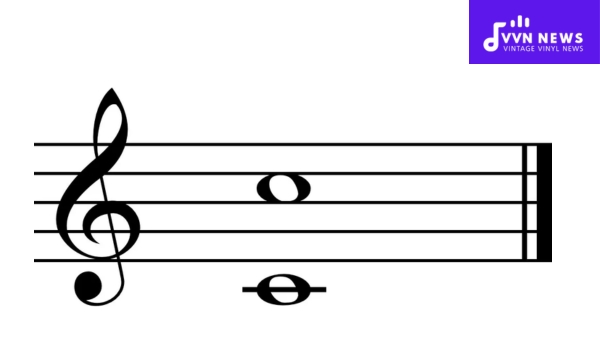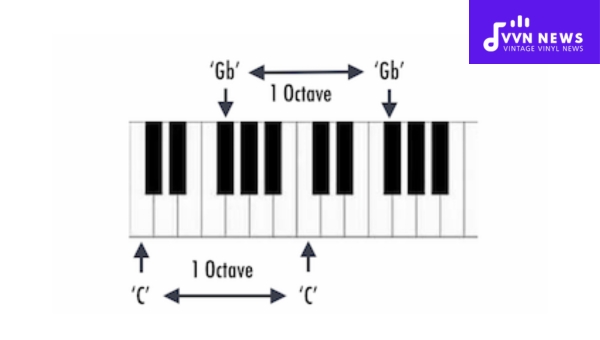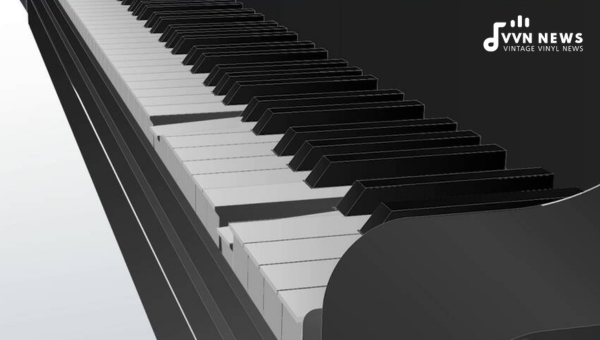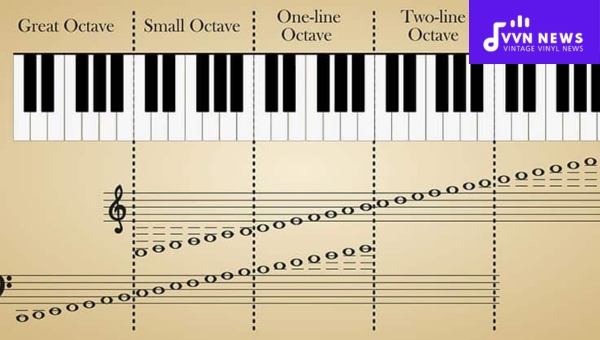Music is an extensive field, filled with nuances and terms that might seem foreign to the uninitiated.
One of these terms is ‘Octave’, which may raise the question: what are Octaves in music? Simply put an octave in music refers to the interval between one musical note and another with half or double its frequency.
This term has its root in a Latin word meaning “eight”, which implies a series of eight notes traditionally found in the diatonic scale.
But you see, there’s more to octaves than meets the eye. To truly understand how octaves in music work and why they are vital to the world of music requires a deeper dive into this fascinating concept.
This exploration will not only enhance your knowledge of music theory but also enrich your ability to appreciate and create music with greater depth and insight.
What Are Octaves?
An octave is a foundational concept in music theory, originating from the Latin word ‘Octava’ signifying ‘eight’.
It’s a musical interval that separates two notes where the higher note is twice as high in pitch as the lower one. If you listen closely, you’ll notice that they have a similar tonal quality to them.
They may sound different in pitch but harmonically, they possess a striking likeness.
Stay mindful of this: although you may usually think of octaves within an eight-note scale (for example, C to the following C on your piano), they are not limited to it.
Octaves regularly surpass traditional scales, providing an essential backbone for musical compositions of all genres.
Also Read: E Major Triad [Master This Staple Of Music Composition]
How Are Octaves Structured in Musical Scales?
In simple terms, an octave represents the distance between two notes where one has twice the frequency of the other.

This concept permeates nearly all systems of music across cultures.
A diatonic scale, for example, which forms much of the basis for Western music, is traditionally composed of seven different notes (e.g., A-B-C-D-E-F-G in the A-major scale).
The eighth note (hence the term ‘octave’), would be an ‘A’ again, but it holds twice or half the frequency depending on if you’re ascending or descending in pitch.
Each interval from ‘A’ to the next higher ‘A’ or vice versa is called an ‘octave.’
The role of octaves in music is significant as it creates a sense of closure or completion within a scale and also imparts consistency to music spanning multiple registers.
Octaves are crucial structuring elements in musical scales, laterally spanning across genres and styles.
What Is the Role of Octaves in Musical Composition?
When composing music, octaves play a significant role in determining the sonic structure and texture of the piece. Here are the crucial roles they usually perform:
- Establishing Melodic Continuity: Octaves are paramount in adding continuity to melodies. By nature, our brains reflect a deep-rooted preference for orderly and predictable patterns. This is where octaves come in handy. For instance, this continuity can be seen when we ‘jump’ from one octave to another while maintaining the same note.
- Harmonic Reinforcement: Music composition often deals with creating harmony, and perhaps, you’ve noticed how song accompaniments usually contain layered notes that often resonate at an octave or more below the central melody.
- Establishing Tonality: Within a musical composition, octaves lend a hand at solidifying tonal structure by providing the fundamental frequencies upon which other intervals and chords are built.
- Creating Sonic Texture: Another fun fact about octaves in music is their potential to enrich your composition’s sonic texture: musicians often use multi-octave spans within both melody and harmony to heighten musical tension or add depth to their pieces.
- Expanding Dynamic Range: Lastly, octave variety can heighten the overall dynamic range of a piece of music, offering increased space for artistic expression.
Octaves are essential ingredients in our musical stew – through establishing melodic coherence, reinforcing harmony, solidifying tonality, or enhancing texture and dynamic range.
Also Read: E Major Triad [Master This Staple Of Music Composition]
How Octaves Help in Playing Piano?
Whenever you’re sitting in front of a piano, you’ll find yourself immersed in a world of black and white keys stretching out before you.

However, did you know that these keys are not as random as they seem? They follow a pattern dictated by octaves in music.
the Basics
Consider an octave as the grandmother of all scales. It consists of eight notes, and on the piano, it spans from one note (say C) to the next of the same name (the next C).
While playing, C to B is an octave, with C being the ‘root note’. One fascinating aspect here is that despite their different pitches when played together or in sequence, these notes sound harmonious rather than dissonant.
Pattern Recognition with Octaves
Recognizing octaves in music visually will greatly improve your efficiency at the piano.
The consistent layout of white and black keys repeats every 12 keys (seven white and five black), forming an octave.
Once you’ve grasped this pattern, finding specific notes becomes easier, leading to quick hands-on-key coordination.
Practicing Octave Techniques
Octaves prove essential while mastering chords or improving dexterity. Isolate just one octave on your piano.
Try playing scales within it. Start basic and slowly experiment with more complex melodies.
This exposure will help build strength and also give fluidity to your finger movements.
Octaves in music provide structure and coherence to music pieces – building blocks that aid beginners while offering scope for creativity for seasoned players.
They tether music together across different pitches so eloquently – one major reason we find music pleasing to our ears!
Also Read: How To Transpose Music? [Simplifying Key Changes In Songs]
What Are Some Famous Examples of Octave Usage in Music?
When we talk about famous songs that effectively leverage octaves, a handful of timeless classics come to mind right away.

Let’s briefly delve into each one to appreciate the subtleties of octave usage.
Somewhere Over the Rainbow by Judy Garland
The iconic opening line of this song involves a giant leap of an octave upwards.
It serves to draw immediate attention and set a magical mood fitting for the lyrics’ fairy-tale theme.
Star Wars Theme by John Williams
This much-loved cinematic score extensively uses octaves to create a feeling of excitement and anticipation.
The bold octave leaps in the main melody serve to make a powerful statement.
My Girl by The Temptations
“My Girl” utilizes octave intervals throughout the song, giving it its distinctive doo-wop feel.
The backing vocals often harmonize on an octave, creating an appealing contrast with the lead vocal line.
Stairway to Heaven by Led Zeppelin
In this popular rock anthem, Robert Plant’s vocal lines often follow an octave pattern that complements Jimmy Page’s guitar riffs which ramp up this song’s emotive horsepower.
The Man Who Sold the World by David Bowie
David Bowie applies octaves as part of his unique music-writing style with bass lines following the vocal melody in different octaves creating depth and fullness in sound texture.
From these examples, it is apparent that octaves can offer musicians more than a theoretical perspective – it opens up new dimensions for creative expression too.
Also Read: Transposition Chart [A Lifesaver For All Musicians]
FAQs
What is an octave?
An octave is the distance between one musical note and another note that has either half or twice the frequency of the first note, resulting in a pitch that feels identically musically.
Can you hear the difference between two notes an octave apart?
Yes, while two notes an octave apart have a similar sonic quality, they are distinct in pitch with one sounding higher or lower than the other.
Do all instruments use octaves?
Absolutely, octaves are a fundamental aspect of music and are used across all melodic instruments and even play a role in percussive tuning.
Why is it easy to sing in octaves?
Singing in octaves comes more naturally because of the harmonic relationship between the notes, making them sound pleasing together despite their pitch difference.
Does each music genre utilize octaves differently?
Yes, genres may emphasize different uses of octaves; for example, classical music often employs them for melodic themes while jazz may use them for improvisation and variation.
Also Read: A Minor Scale [Unlock The Mysteries Of Musical Composition]
Conclusion
Octaves are a core element in music that shape the framework of melodies and harmonies alike.
They bridge the gap between pitches, ensuring a sense of cohesion in musical pieces. Internalizing the concept of octaves can vastly improve your musical comprehension and performance.
If you’re a budding musician or a seasoned listener, recognizing and utilizing octaves will undeniably unlock new dimensions of auditory exploration and appreciation within your musical journey.








